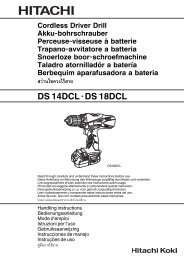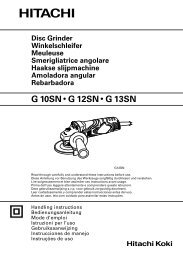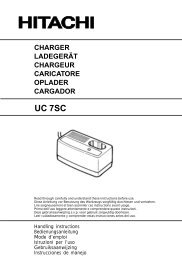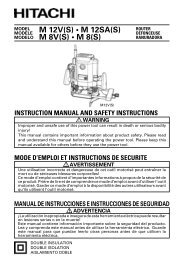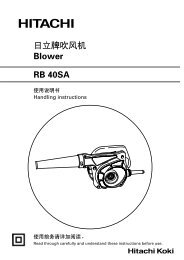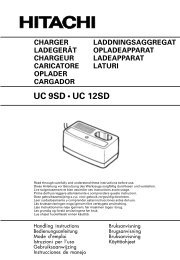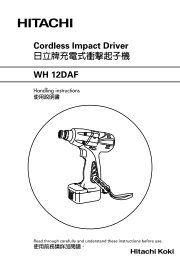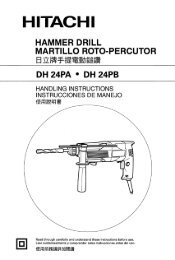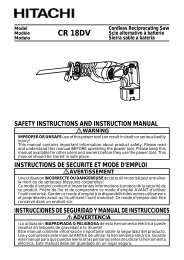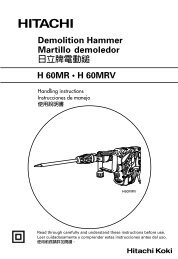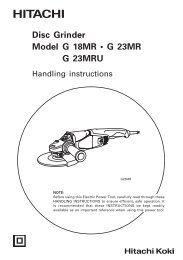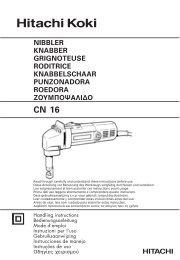e - Hitachi Koki Co., Ltd.
e - Hitachi Koki Co., Ltd.
e - Hitachi Koki Co., Ltd.
Create successful ePaper yourself
Turn your PDF publications into a flip-book with our unique Google optimized e-Paper software.
ADJUSTING THE SCREW LENGTH AND<br />
SCREW-IN DEPTH<br />
1. Set the screw length (Fig. 1)<br />
Set the screw length on this unit by sliding the guide<br />
block.<br />
(1) Slide the guide block while holding down the lever<br />
and align the arrow on the guide block with the<br />
number on the stopper to match the screw length.<br />
(2) Find the screw length and screw guide position by<br />
checking the table below.<br />
STOPPER NUMBER SCREW LENGTH<br />
28 25 – 28 mm<br />
32 32 – 35 mm<br />
41 38 – 41 mm<br />
2. Adjust the screw-in depth (Fig. 2)<br />
Adjust the screw-in depth on this unit by turning the<br />
depth adjuster knob.<br />
(1) Press the slider all the way in to the slider case. Then<br />
rotate the depth adjuster knob so that the bit tip<br />
protrudes about 5 mm.<br />
(2) Try driving a screw and make fine adjustments as<br />
needed. To make the fine adjustment, rotate towards<br />
A (counterclockwise) if the screw head is too high<br />
after screw-in. If the screw head is too low after<br />
screw-in, then rotate towards B (clockwise).<br />
INSTALLING AND REMOVING THE SCREW<br />
STRIP<br />
1. Install (Fig. 3)<br />
(1) Insert the tip of the linked screw strip into the belt<br />
guide groove (A section).<br />
(2) Insert the tip of the tape into the slider groove (B<br />
section) and press inwards in the arrow direction.<br />
(3) Set so the screw on the strip is just prior (1 screw<br />
width) to the screw-in position (Fig. 4, Fig. 5).<br />
CAUTION<br />
Set the screw strip securely inside. If not set securely,<br />
the bit might scratch the board surface (low feed<br />
pressure) or the screw might be wasted (too much<br />
feed pressure).<br />
2. Removal (Fig. 6)<br />
(1) If you run out of screws on the tape or want to<br />
remove a screw strip during a job, pull in the direction<br />
of the arrow as shown in the figure to remove.<br />
(2) You can return the screw strip in the opposite direction<br />
by pressing the reverse button.<br />
INSTALLING AND REMOVING THE BIT<br />
CAUTION<br />
To prevent the chance of an accident, always turn off<br />
the power switch and pull out the plug from the<br />
socket.<br />
NOTE<br />
When replacing the bit be sure to install it securely so<br />
it will not come loose or fall out later.<br />
1. Removing the screw strip attachment<br />
Grip the unit securely with one hand. With your other<br />
hand, rotate the screw strip attachment in the direction<br />
English<br />
of the arrow in Fig. 17. Next pull in the direction of<br />
the arrow in Fig. 18 and remove.<br />
NOTE<br />
This will be hard to remove if the lath or plaster<br />
powder attaches near the attachment slot. Clean this<br />
section carefully to prevent the lath or plaster powder<br />
from adhering here.<br />
2. Attaching and removing the bit (Fig. 7)<br />
No bits other than plus driver (Phillips) bits (No. 2,<br />
136 mm long) can be used for screw strip tightening<br />
jobs.<br />
Attach the bits securely using the following procedure.<br />
Move the guide sleeve to the top edge, feed the bit<br />
into hexagonal hole on the anvil and then release the<br />
guide sleeve.<br />
To remove, perform the above procedure in reverse<br />
order.<br />
NOTE<br />
The bit was not installed correctly (securely) if the<br />
guide sleeve will not return to its original position.<br />
Keep inserting the bit inside the hexagonal socket<br />
head hole until it makes contact.<br />
3. Installing the screw strip attachment<br />
Install using the steps in “1. Removing the screw<br />
strip attachment“ in reverse order.<br />
HOW TO USE<br />
CAUTION<br />
Always use safety goggles during the work.<br />
1. How to operate<br />
Press the unit straight up against the work and pull<br />
the switch trigger to automatically feed and tighten<br />
the screws (Fig. 8).<br />
NOTE<br />
Place this unit straight up against the work during<br />
screw-tightening. Using the unit while at an angle to<br />
the work might damage the screw head or cause bit<br />
wear. Also the proper tightening torque will not be<br />
transmitted to the screw and might cause the screw<br />
to seat improperly.<br />
Press firmly on the unit until the screw tightening is<br />
complete. Loosening the pushing pressure on the<br />
unit might cause the screw to seat improperly.<br />
When driving the screw, avoid hitting the unit as<br />
pushing in.<br />
This could prevent the screw from being sent<br />
normally.<br />
Attempting to tighten one screw on top of another<br />
will cause the screw to fall or stop the screw feed so<br />
use caution.<br />
Driving blanks<br />
During continuous screw tightening, you might not<br />
notice you have run out of screws and continue to<br />
operate the unit. Driving without any screws will<br />
cause the bit to damage the lath or plaster board, so<br />
do the screw tightening while checking the number<br />
of screws remaining.<br />
If the slider does not move smoothly, try cleaning the<br />
sliding surfaces with an air gun, etc.<br />
2. Using in corners (Fig. 9)<br />
Unit can drive screws at positions as close as 15 mm<br />
from the wall.<br />
NOTE<br />
Do not attempt to drive screws when closer to the<br />
wall than 15 mm.<br />
8



